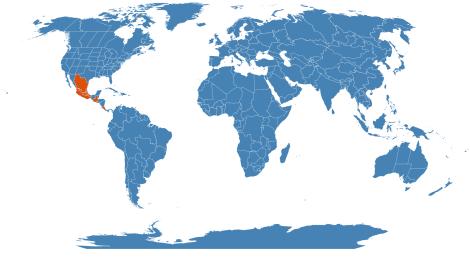Accession Data
Casimiroa edulis
Common Name: White Sapote, Mexican Apple, Zapote Blanco
Family: Rutaceae
Country of Origin: Mexico and central America
Description: The casimiroa (Casimiroa edulis) is native to the tropical highlands of Central and South America. Although a popular common name of the fruit is white sapote because of its white flesh, casimiroa is not in the sapote family. In Mexico casimiroa is also known as zapote blanco and abache. The fruit was well known to the Aztecs. The leaves, bark and seeds contain the glucoside "casimirosine", which lowers blood pressure. In large doses, glucoside acts as a sedative, and alleviates rheumatic pains. It has been reported that a tea produced from the leaves would induce sleep within an hour. Some have suggested counting trees in an imaginary orchard as effective as drinking this green tea.
Reflecting the diversity of seedlings, numerous named varieties are propagated. Of these, several have desirable attributes for gardens and some may become useful in commercial planting. Primarily a dessert fruit, casimiroa is very sweet (27% sugars), highly nutritious, and rich in vitamins, including A and C. The pulp is smooth and has no noticeable fibre. Unfortunately, some varieties are bitter near the paper thin skin. To avoid the bitter pulp, the fruit may be thickly peeled, or soft fruit may be halved and scooped out, avoiding the pulp near the skin. Fruit size, seed to flesh ratio, taste and other characteristics vary greatly between varieties. Generally, fruit are 75 - 125mm in diameter.
Uses: In prepared dishes, casimiroa is frequently combined with milk to produce ice creams, milk shakes or pies. With added lemon or lime juice, the fruit makes a good jelly, and also sherbets. Casimiroa may also be dried as a fruit leather. Colour on maturity ranges from dark green to yellow. These green maturing fruit lighten a shade when ready for harvest. Harvested fruit softens and turns yellowish within a few days. Fully tree-ripened casimiroa are attacked by insects. Indeed, this fruit requires spraying against fruit fly from six weeks prior to harvest. Growers not willing to maintain a spray schedule should not attempt to produce casimiroa, unless they are in a fruit fly free area. Ripe fruit is quite perishable but it may be refrigerated. However, it is best to use fruit as soon as possible. Casimiroa may be frozen whole, as pieces or as a pulp. Taste is not noticeably affected, and after thawing it may be used like fresh fruit for most purposes.
Accession Data
USDA Zone: 9b-11
Accession #: 199900052
Accession Date: 1999-05-19 00:00:00
Bloom Status: 🪴 Not Flowering
Location: 1310
Quantity: 1
Source: John Maugeri
Culture: The casimiroa (Casimiroa edulis) appears to grow best on well drained light soils supplemented with large amounts of organic matter. A good, consistent supply of water is important. In the absence of other information, a citrus fertiliser programme rich in N is probably suitable.
Classification
Division: Magnoliophyta
Class: Magnoliopsida
Subclass: eurosid II
Order: Sapindales
Family: Rutaceae
SubFamily: Toddalioideae
Flowering Data:
This accession has been observed in bloom on:| Year | Jan | Feb | Mar | Apr | May | Jun | Jul | Aug | Sep | Oct | Nov | Dec | ||||||||||||||||||||||||||||||||||||||||
|---|---|---|---|---|---|---|---|---|---|---|---|---|---|---|---|---|---|---|---|---|---|---|---|---|---|---|---|---|---|---|---|---|---|---|---|---|---|---|---|---|---|---|---|---|---|---|---|---|---|---|---|---|
| 2025 | ||||||||||||||||||||||||||||||||||||||||||||||||||||
| 2024 | ||||||||||||||||||||||||||||||||||||||||||||||||||||
| 2023 | ||||||||||||||||||||||||||||||||||||||||||||||||||||
| 2022 | ||||||||||||||||||||||||||||||||||||||||||||||||||||
| 2021 | ||||||||||||||||||||||||||||||||||||||||||||||||||||
| 2020 | ||||||||||||||||||||||||||||||||||||||||||||||||||||
| 2019 | ||||||||||||||||||||||||||||||||||||||||||||||||||||
| 2018 | ||||||||||||||||||||||||||||||||||||||||||||||||||||
| 2017 | ||||||||||||||||||||||||||||||||||||||||||||||||||||
| 2016 | ||||||||||||||||||||||||||||||||||||||||||||||||||||
| 2015 | ||||||||||||||||||||||||||||||||||||||||||||||||||||
| 2014 | ||||||||||||||||||||||||||||||||||||||||||||||||||||
| 2013 | ||||||||||||||||||||||||||||||||||||||||||||||||||||
| 2012 | ||||||||||||||||||||||||||||||||||||||||||||||||||||
| 2011 | ||||||||||||||||||||||||||||||||||||||||||||||||||||
References
- Know & Enjoy Tropical Fruit Website
- HortNET Website
- The Plant List (2013). Version 1.1. Last accessed on Monday, August 08, 2016.
- Casimiroa edulis at ARS-GRIN. Last accessed on Monday, August 08, 2016.
Images

